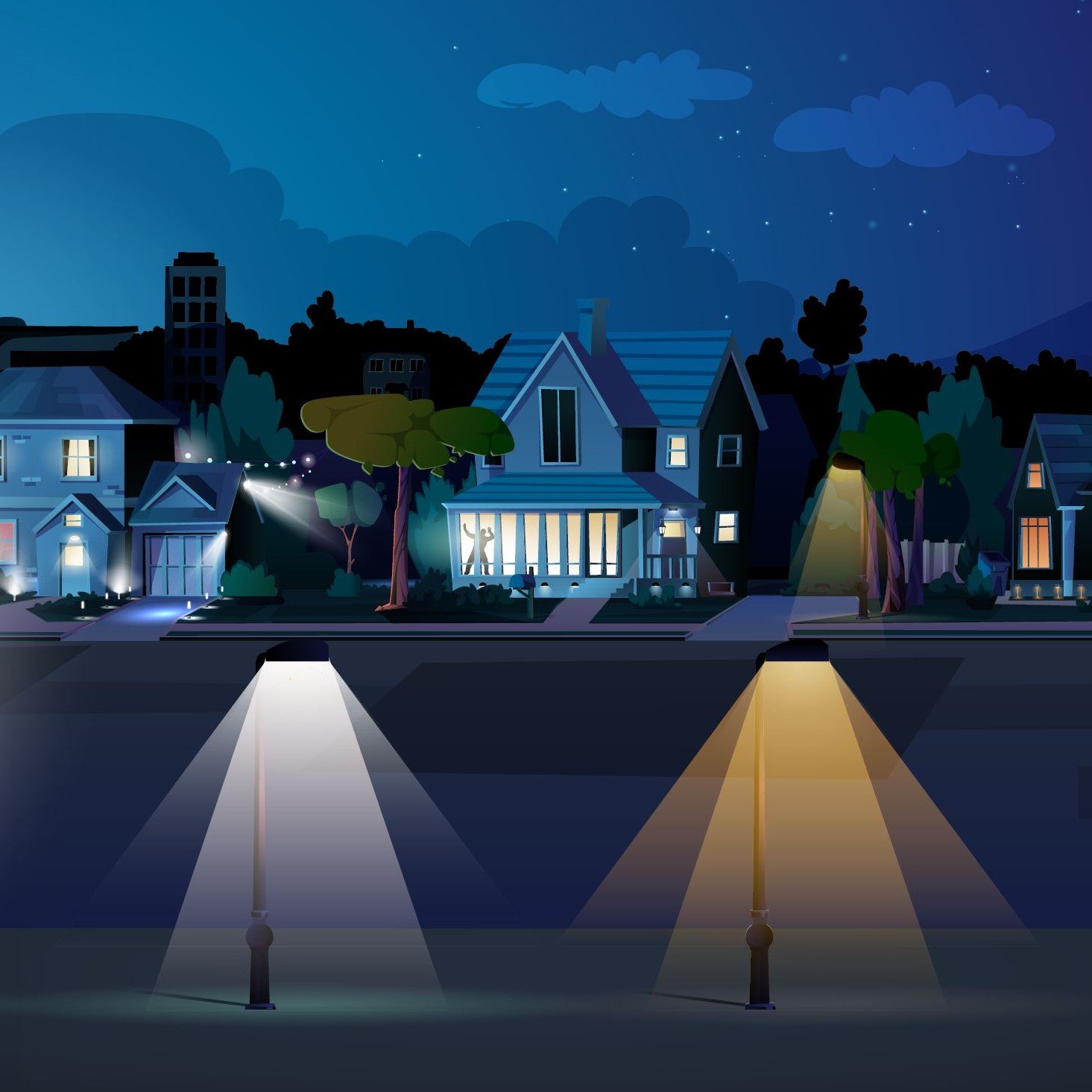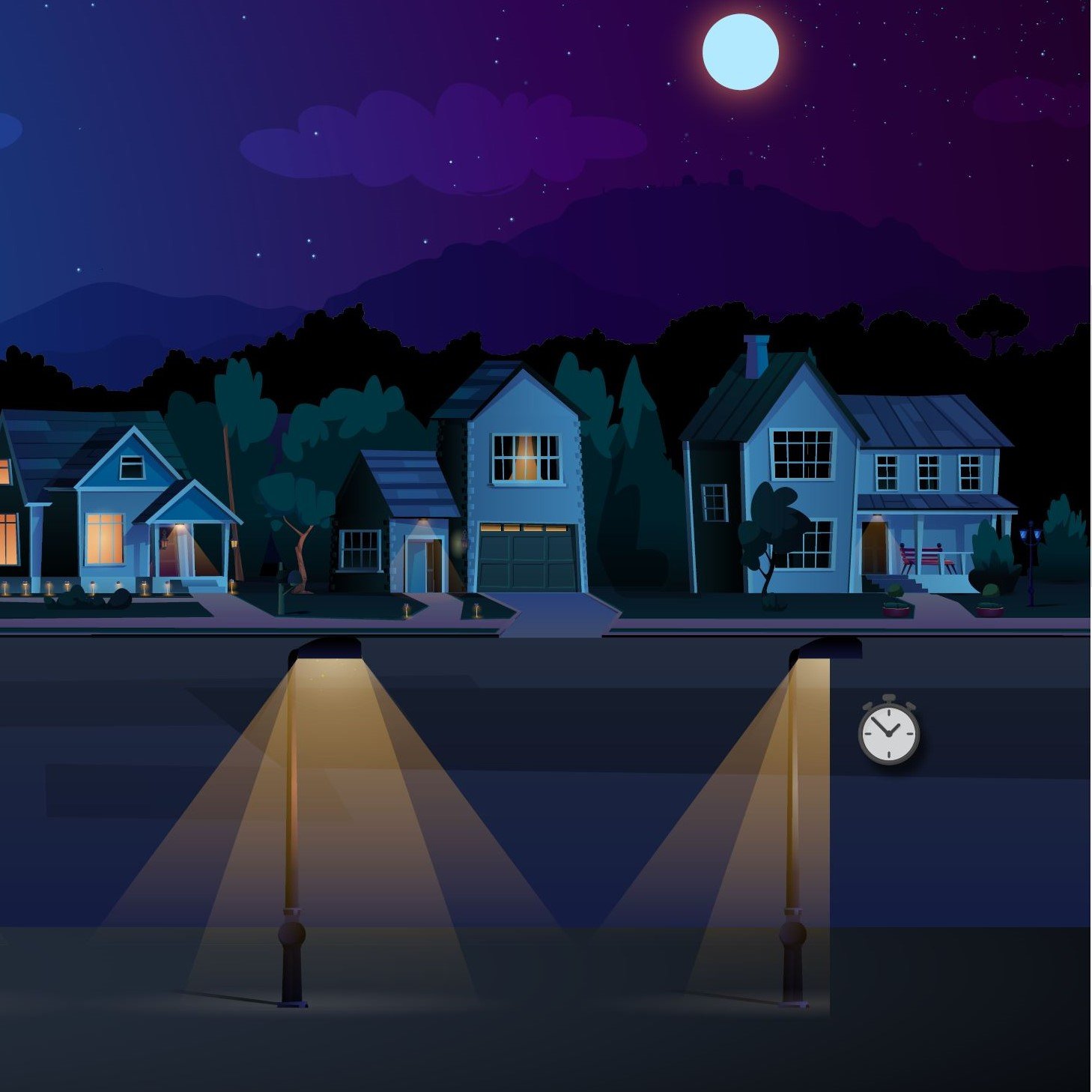Simple Steps for Better Lighting
We don’t need to live in darkness to reduce light pollution.
The Four Steps: Shielding, Color, Intensity, and Timing.
Outdoor lighting ordinances in the reserve follow these steps so we can all enjoy the stars.
Shielding
Point lights down and check lighting after dark to ensure the light is not going into the sky or onto neighboring property.
The streetlight to the far left has an example of an unshielded light fixture that clearly produces light pollution. To the right is a “full cut-off” or “fully shielded” light fixture. Fully shielded fixtures make the use of light more efficient by directing light where it is needed. These fixtures eliminate glare, provide better visibility and the efficient use of light saves money.
Color
Choose amber colored or soft-white lights.
White light tends to scatter more in the air and obscure our view of the stars, while amber or red light scatters less. It's best to avoid blue or white light at night since they can be harsh and cause glare. Additionally, white and blue light can have adverse effects on wildlife, plants, and human health.
Lighting manufacturers use temperature in Kelvin (K) to describe the color of light. The higher the color temperature, the more blue light the product contains. It's best to choose values no higher than 2700K (soft white), and lower numbers are even better.
Intensity
Only use the amount of light you need for the task, and no more.
Lumens are used to measure the amount of light a source emits. Typically, 800 lumens per fixture is sufficient for most residential purposes. Avoid over-illuminating an area, as it can be wasteful and impair visibility by forcing your eyes to adjust to bright conditions. To see clearly, your eyes need smooth transitions in light levels, so brighter lights aren't always better.
Purpose and Timing
If you are not using a light, turn it off or put it on a timer to turn off automatically.
Make sure that the light has a good purpose for being left on, and for existing in the first place. If you are worried about security, use a motion sensor light or infrared camera to monitor an area instead of leaving a light on all night. Having a light on all the time may simply draw unwanted attention and make it easier for thieves to identify targets of value, especially in an otherwise dark area. Numerous studies find that turning lights off after 11pm or midnight reduces crime and accidents but leaving lights on can increase crime in some situations.
Turn off business signs and decorative lights upon closure or by 11pm.
Find Night-Sky Friendly Lights
Keywords
Whether searching online or looking at packaging in a store, here are some phrases to look for:
Dark-Sky Compliant
IDA Seal of Approval
Fully Shielded
Full Cut-off
Night Sky Friendly
Bug Light
Blue light blocking
2000K, 2200K, or 2700K Color Temperature
Turtle Friendly
Wildlife Friendly
Florida Fish & Wildlife Certified
Residential Lighting
Most local hardware stores will sell lighting that is night-sky friendly. See these pages for lists of known night-sky friendly lighting at hardware stores in the Big Bend:
Look for full shielded fixtures and amber or soft-white bulbs on shelves. See the graphic guide below for details on fixtures.
The International Dark Sky Association maintains an online database of certified fixtures.
You can also filter a search for dark-sky compliant fixtures on some major online retailers’ websites such as Home Depot, Lowes, or Build.com, but always double-check that the light meets the principles above.
Don’t want to deal with hunting for a specific bulb? Many “smart lights” can be tuned to be any color or intensity you want, or even programmed to follow a schedule, allowing them to easily be made night-sky friendly.
Commercial & Street Lighting
Be sure to fully review your local outdoor lighting ordinance before installing any new lighting.
Minimizing blue light content is important, especially for projects using 5,000 or more total lumens. The following brands offer solutions for commercial or industrial scale applications. Ask a sales rep about 2200K, 2700K, PC-Amber, Narrow Band Amber, or Blue-Light Blocking options. These options are often available upon request even if not listed online.







